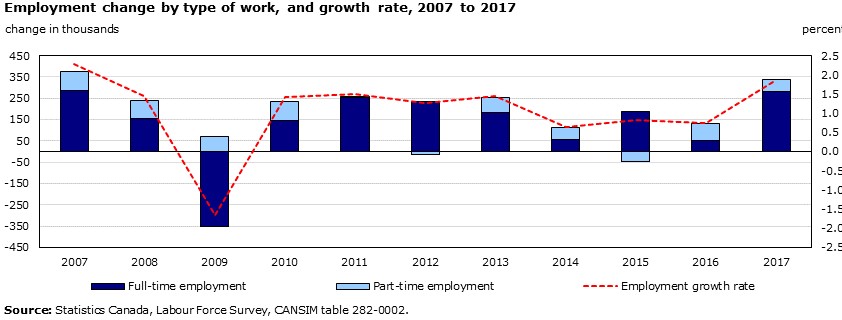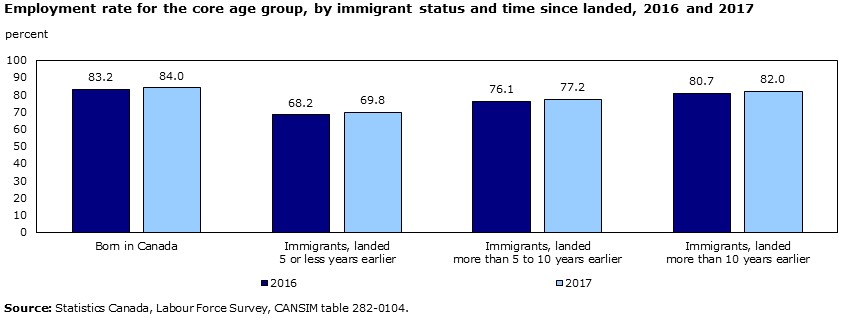Employment in Canada’s tech and health sectors grew significantly in 2017, part of an overall trend that saw total employment grow at its quickest rate in a decade.
Statistics Canada’s annual labour market review for 2017 shows that total employment across Canada rose by 336,500, or 1.9 per cent — the fastest rate of growth since 2007. Most of that growth — 280,600 — was full-time employment.
Canada also posted the largest year-over-year decline in its unemployment rate since 2000, dropping 0.7 percentage points to 6.3 per cent.


Tech sector jobs boom
Professional, scientific and technical services was “one of the fastest growing sectors in 2017,” the report says, posting a year-over-year increase of 29,300 people employed in 2017, an increase of 3.4 per cent and the fastest rate of employment growth in the tech sector since 2008. Statistics Canada said most growth in this sector was in computer systems design and related services.
“This is a high-skilled, high-earning industry, with average weekly earnings of $1,577 (up 2.9 per cent from 2016),” Statistics Canada reports.
Growth in tech sector employment was driven by Ontario, which posted an increase of 14,100 jobs in 2017, followed by Quebec, which witnessed an increase of 10,600 positions.
Despite this growth, the sector still had a “relatively high” job vacancy rate of 3.1 per cent.
Immigrants see ‘strong’ employment growth
While down from the previous two years, landed immigrants still experienced what Statistics Canada called “strong employment growth” of 2.7 per cent in 2017. At the same time, the unemployment rate for immigrants dropped by 0.8 per cent to 6.7 per cent, the lowest annual rate since data became available in 2006.
“The gap in the unemployment rate between immigrants and Canadian-born has been less than one percentage point since 2015,” Statistics Canada noted.


Employment rates improved more among core aged immigrants (25-54) than their Canadian-born cohort mates in 2017, with the largest increase (1.6 percentage points) occurring among immigrants who had landed in the previous five years. The employment rate for people born in Canada rose by 0.8 percentage points.
The employment rate for landed immigrants in Canada between five to 10 years was 77.2 per cent and those in Canada 10 years or more was 82 per cent.
Ontario sets the pace
Employment growth was spread across most Canadian provinces, with Ontario, Quebec and British Columbia leading the way.
Ontario, Canada’s most populous province, had 128,400 more people employed in 2017 than the year before. Ontario’s unemployment rate of six per cent in 2017 was the lowest it has been since 2000.
Growth was highest in Ontario’s accommodation and food services sector, followed by health care and social assistance and professional, scientific and technical services.
Toronto posted the highest pace of employment growth among Ontario’s economic regions last year with an increase of 69,700 more people employed than in 2016. The top four Ontario economic regions in terms of employment growth was rounded out by Hamilton–Niagara Peninsula, Kitchener–Waterloo–Barrie and Muskoka–Kawarthas.
Strong labour market in Quebec
Employment grew in Quebec by 90,200 in 2017, an increase of 2.2 per cent and the largest level increase in the province in 10 years. Most of that growth – 65,400 – was full-time work.
Quebec’s annual unemployment rate also fell a full one per cent over the previous year to 6.1 per cent. Statistics Canada further notes that unemployment hit five per cent in December 2017, the lowest it has been since 1976.
The bulk of Quebec’s employment growth occurred in the Montreal and Montérégie economic regions and was led by the manufacturing and professional, scientific and technical services sector.
Canada’s lowest unemployment rate in British Columbia
On Canada’s West Coast, British Columbia posted the lowest unemployment rate in Canada in 2017, at 5.1 per cent — a drop of nearly one per cent over 2016. Employment in B.C. grew by 87,300, or 3.7 per cent, last year.
B.C. also had Canada’s highest job vacancy rate last year, at 3.8 per cent.
The sectors with the largest payroll employment increase in British Columbia in 2017 were accommodation and food services, construction and health care and social assistance.
Health care and social assistance top among sectors
Statistics Canada says the majority of payroll employment growth in 2017 (219,000) took place in services-producing sectors. The health care and social assistance sector led the way with an increase of 39,600 over 2016, the fourth year in a row that this sector has led payroll employment growth. The largest increase in this sector was posted in Ontario, with 14,600, followed by Quebec with 8,400.
One health care industry that has seen consistent employment growth is community care facilities for the elderly. Statistics Canada said growth in this industry has more than doubled since 2006, which reflects “the needs of aging population. The number of people over the age of 65 and older increased by 36.9 per cent between 2006 and 2016.”
Rounding out the top three sectors for employment growth was accommodation and food services, professional, scientific and technical services and manufacturing.
Participation rate for women hits record high
The labour force participation rate by women in the core 25 to 54 age group rose to 82.9 per cent, the highest level on record. The rate was highest in Quebec (86.8 per cent), which Statistics Canada said may be due to low-cost childcare in the province.
The growth rate of women in management positions was the fastest since 2004, driven by female managers in professional, scientific and technical services, among other sectors.
Women in management positions also experienced growth in hourly wages that was more than four times faster their male counterparts, rising by 4.1 per cent in 2017.
Other notable findings:
- Average weekly earnings increased in most provinces, with above national average increases in Quebec, British Columbia, Manitoba and Saskatchewan.
- Employment increased among Canada’s core-aged population (25 to 54) by 166,000, or 1.4 per cent — the fastest growth rate since 2000.
- The fastest growing occupational group for men was health occupations, which recorded an increase of 8.9 per cent — the fastest rate of growth since 1993.
- Employment among people 55 and older rose by 141,000. The participation rate for this age group also rose to 37.9 per cent, the highest it’s been since 1976.
- The number of employees with temporary jobs grew at a much faster pace than those with a permanent job (5.3 per cent compared to 1.4 per cent). This continues a trend observed since 1997.
- In 2017, 5.6 per cent of employed people had more than one job.
© 2018 CICNews All Rights Reserved